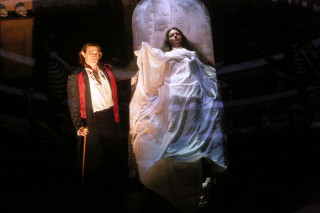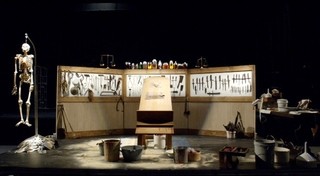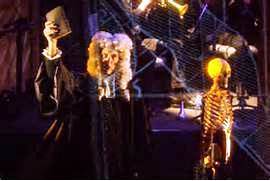|
Back
Gruesome, Gory and Gorgeous New York
BRIC Media
01/07/2017 - & January 8, 10, 12, 13, 14, 2017
Prototype Festival:
David Lang: Anatomy Theater
Peabody Southwell (Sarah Osborne), Marc Kudisch (Joshua Crouch), Robert Osborne (Baron Peel), Timur (Ambrose Strong)
Members of International Contemporary Ensemble, Christopher Rountree (Music Direction)
David Lang (Co-librettist), Mark Dion (Co-librettist, Scenic Designer), Bob McGrath (Director), Chrisopher Kuhl (Lighting Designer), Bill Morrison (Video Designer), Alixandra Gage Englund (Costume Designer), Garth MacAleavey (Sound Designer), Ryan Gohsman (Stage Manager), Julie Hurley (Assistant Stage Manager)

M. Kudisch, P. Southwell (© Craig T. Matthews)
”No singers were harmed in the creation of this opera”
First line of program introduction, by David Lang and Mark Dion
Are they absolutely certain? It seems to me, and the packed auditorium in BRIC that Peabody Southwell was plenty harmed. After being marched through the BRIC corridors, reviled and beaten as a “Murderess”, Ms. Southwell found herself on the stage in horrific pain, hands tied together by shackles and ropes, knocked about by the sadistic Marc Kudisch. After this she seemed to have been hung by a noose, her body suspended for about five minutes. That, though, was the beginning. A few minutes later, supposedly dead, ready to be dissected, she was stretched out on a board totally naked and the organs of her body–spleen, heart, uterus–were removed, blood dousing her body as young anatomist Timur weighed each organ.
And the only way we knew she was still alive was that she sung about her heart, whilst tied on the board.
Anatomy Theater, David Lang’s latest surprise (for Mr. Lang never ever repeats himself) is not Grand Guignol, it is not shock theater, it is not exactly opera (though players from the International Contemporary Ensemble played on the stage behind the gallows and anatomy lab).
Instead, for this first New York performance in the festival of the brilliant new-opera producers Prototype, Mr. Lang gave serious drama indeed, a malevolent tale of torture in the name of science. And in a way, Mr. Lang, with his co-librettist Marc Dion, have a moral purpose, to show the utter misogyny of the early 18th Century (“Her only crime,” says Professor Peel, “is to have been born a woman.”) Equally, Anatomy Theater shows the sadism and horror of those times, without a thought for human feeling.
Anatomy Theater might possibly–though this is only my thought–be a metaphor of our own times, how we torture our enemies in the name of “intelligence”, or torture animals in the name of science.

M. Dion’s Anatomy Room (© Bricartsmedia.org)
Yet any possible thoughts above are immediately–instantaneously–put to rest by the utter, almost unearthly beauty of this production.
Are skulls and skeletons beautiful? Well, yes, they are us (and far less splotched and battered by our own skins). Are archaic anatomical tools–needles, mallets, hammers, pins, all announced with glee by the sadistic Mr. Kudisch–things of adoration? The very horror of these tools, of the simulated extraction of organs, has a ghoulishness balancing in tandem with the exotic.
And ironically, the most beautiful parts of all are demonstrated on (what resemble) holograms on the transparent screen across the stage. First Hogarthian-style lithograms, then 18th Century pictures of medical operations, symbols of the tools and equally archaic drawings of the organs, including the kind of beating heart which William Harvey had drawn a century before. And then, as the victim’s heart is extracted, these video productions (or holograms) are shown wiggling (if 18th Century graphic drawings could wriggle) as they proceed across the screened stage.
Even more essential, Mr. Lang–who once confessed to being attracted by words more than music–here was showing attractions for Ye complete theatrical piece, like an operatic version of Antonin Artaud’s theater of cruelty.
Even before entering the concert-room, we visitors were sent to the “Barber” or “Surgeon” room to feast on “pre-hanging” tankards of beer and plates of sausages, served up by wenches in Moll Flanders costume.
And once led into the bleachers to witness the hanging and its aftermath, we were equally part of the show. The notorious Joshua Crouch (Mr. Kudisch, vamping, laughing, glowering) addressed us, the audience who had paid to see the hanging as “Gentlemen” (he says that word like The Joker!), given tickets not only for the punishment but dissection to “discover her evil” on her organs.

R. Osborne (© Redcat.org)
This was given by the “scientist” of the evening, Baron Peel (Mr. Osborne) and his assistant. With all the details, all the gore, all the “Ugh” and “blech” factors, even more intact that the dissected organs.
It was gruesome but amazing. It moved, it played with our own emotions (“None of you gentlemen,” sneers Mr. Kudisch, “objected to the murderess being hung”), And with the magic that David Lang produces his music, Director Bob McGrath took us back centuries and onto a usual British spectacle.
As for the music... Well, here was another irony. That same night, across the East River at Lincoln Center, was another reproduction of 18th Century hanging (or near hanging), Kurt Weill’s Threepenny Opera for the NY Philharmonic winds. And one must admit that Weill’s music was not only mordant, wicked, cutting, but it was a lot more musical.
Yes, Mr. Lang provided opera moments. Ms. Southwell chanted-sung her story, and gave an aria when her heart was removed. Ms. Kudisch recited his “gentleman’s” song with words almost bursting out at the audience. (He was so so reminiscent of Robert Helpmann in the film of (Tales of Hoffmann) Mr. Osborne took the dissection instruments and recited the virtues of each one as if describing a recipe. The ensemble of International Contemporary Ensemble did the rest with drum pounding and string throbbing.
The finale, where all four characters sing their gruesome chorale is very much Rake’s Progress style. But if its purpose was to bring us, the Witnesses, back to reality, that failed. Anybody who saw this quartet hung, drawn, quartered with such fastidious care and sanguinary glee was still in the agonies of this production.
Thank goodness for Protoype that they are repeating Anatomy Theater six times more. I have doubts that seats are available (my own was graciously given me a few hours before the performance), but one should try and try and try again. David Lang has been prodigious in his work since The Little Match Girl, but Anatomy Theater is by his most epic, singular and fascinating creation. As well as (remembering the hanging and anatomy) his most mesmeric destruction.
CODA: Prototype is offering seven new operas this month at seven different venues. All the information is at www.prototypefesstival.org
Harry Rolnick
|